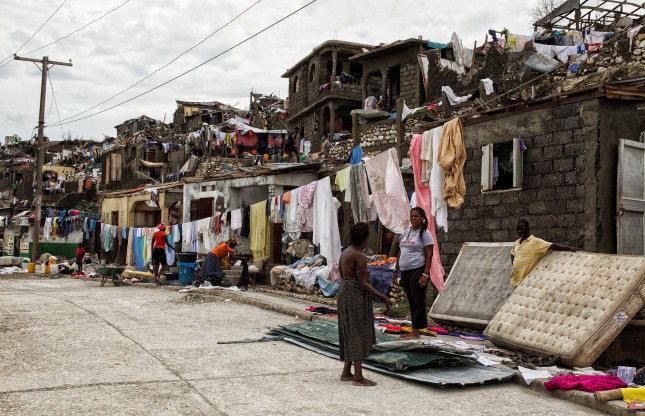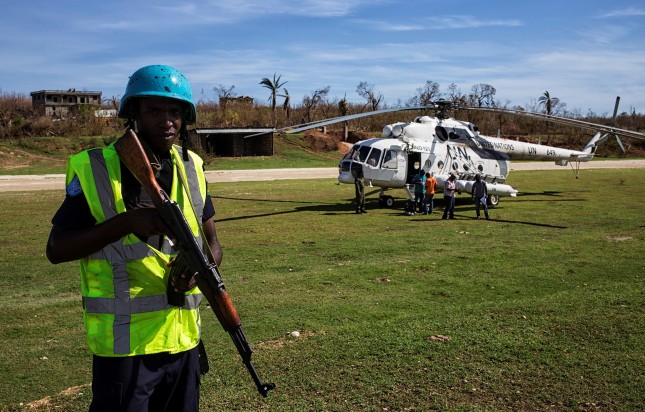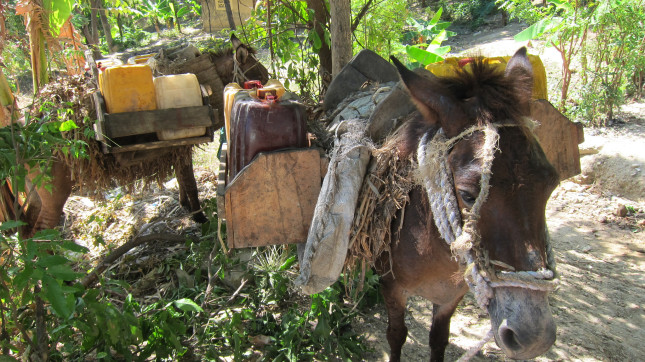Haiti’s Cholera Spreading, Money Grubbing, United Nations Plague

If the United Nations caused 10,000 deaths and 700,000 cholera infections after Haiti’s January 12, 2010 disastrous earthquake, then it stands to reason that a continued association with the UN after six years of inaction on the cholera, plus the ravages of Hurricane Matthew, could only lead to more Haitian deaths.
Former UN Secretary General, Ban Ki-moon, flew over the city of Aux Cayes, in southern Haiti on Saturday, October 16, 2016, and he visited a high school where some people are sheltered. The wet mattresses from Hurricane Matthew had hardly dried before Mr. Ban Ki-moon and his associates began to plot for the UN to prolong its mandate in Haiti.
The UN was due to leave in six months, now it will be a year. There should be no more need for a UN force, now that it has trained about 16,000 Haitian police as its replacement. There is, however, money in cholera and rigged elections. As journalist Kim Ives predicted, the pretext put forward by the UN is that it will need to stay until Haiti elects its next government. The hurricane has caused the postponement of Haiti’s first-round presidential elections and some legislative elections to November 20, 2016. These will be a retake of the rigged elections of 2015 that were financed mostly by the United States through the UN Development Programme (UNDP).
Only two months ago, Ban Ki-moon was beginning to act contrite for exacerbating the effects of the earthquake by plaguing the island nation with cholera. Together with his UN Special Envoy, Bill Clinton and then Secretary of State Hillary Clinton, he had prevented a representative government from burgeoning and burdened Haiti’s fragile infrastructure with thousands of UN troops from Southeast Asia, where cholera is endemic. Mr. Ban Ki-moon acknowledged in mid-August 2016 that Nepalese troops had infected Haiti and attributed this admission to a report on August 8 from UN advisor Philip Alston, a professor of law at New York University.
This sudden reversal, after years of refusal to take responsibility for the cholera, was most likely occasioned, not by Alston’s report, but by my article on January 8, 2016. This article revealed to the general public that, even while the UN successfully fought two lawsuits by Haitians, it was infecting Haiti yet again, after 2012, with cholera from Bangladesh. Having closely followed the scientific literature on cholera, I reported the news that Dr. Andrew Camilli’s team at Tufts University had discovered a cholera virus called ICP2 in Haitian patients that could only have accompanied cholera bacteria in the untreated wastes of Bangladeshi soldiers.
The first group of soldiers from Bangladesh, an all-female unit, joined the UN police contingent in Haiti in 2012. Alston’s report also stated that sanitation at the UN bases in Haiti had remained shoddy even after 2010. In my view, the AP story on this report in the New York Times, which pretended to be critical of the UN, was nothing but a cynical preparation of the public opinion for the news that additional cholera strains from Bangladesh currently exist in Haiti.
As of this writing, UN missions have infected at least eight other countries with cholera. They are: the Democratic Republic of the Congo (DRC), Darfur, South Sudan, Mali, Central African Republic (CAR), Ivory Coast, Liberia, and Abyei. In addition, the UN has always lied about the cholera in Haiti.
In 2010, the UN was first to learn that it had infected Haiti with Vibrio cholerae from Nepal, but it kept quiet about it. The initial cholera infections in Haitians appeared five days after 1,280 Nepalese troops were returned to Haiti from training in Kathmandu plus a 10-day home leave throughout Nepal in the midst of a cholera epidemic. In Haiti, the soldiers were set up in three camps from which their untreated wastes were dumped in waterways that fed the Artibonite River. This contamination amounted to more than one bathtub of pure choleric waste with billions to trillions of cholera bacteria per liter being dumped into the river! Without this, the cholera bacteria in the Artibonite would never have reached the concentrations to kill residents downstream of these camps within hours. It is almost certain that several Nepalese troops became violently ill on base and that the UN plus the medical personnel who treated the troops, probably from the nearest hospital in the city Mirebalais, have covered up these events.
Immediately after the onset of the epidemic, the UN began to clamor for money and for oral cholera vaccines via its Pan American Health Organization (PAHO). As part of a study to develop vaccines against the cholera, the UN demonstrated to itself conclusively, well before any other molecular genetics studies, that the cholera in Haiti was identical to cholera from Nepal. This work was done by a UN researcher who reported it to Dr. Dong Wook Kim at the International Vaccine Institute, in South Korea. The UN also kept this secret to itself. Incidentally, South Korea, which is also involved in Haiti’s sweatshop complex at Caracol, happens to be the country where Ban Ki-moon originates.
The nightmare is upon us again. One week after Hurricane Matthew, the UN’s World Health Organization (WHO) donated one million doses of oral cholera vaccines to Haiti, although the Haitian government had instead asked for help with infrastructure to provide clean drinking water to the population. The vaccines represent a gold rush for Deputy UN Special Envoy Paul Farmer’s NGO Partners in Health (PIH), which will get paid to administer the vaccines. As in 2010, the mainstream media, especially The Guardian and NPR, are vigorously promoting vaccines and functioning as bullhorns for the Bill and Melinda Gates Foundation, which has financed, not only the development of the oral cholera vaccine at the International Vaccine Institute but also its manufacture under the name Shanchol by a subsidiary of the French pharmaceutical giant, Sanofi Pasteur.
The current promotion of oral cholera vaccines is a deceitful campaign motivated by pure greed. Vaccination against cholera in Haiti right now is worse than useless. First, even inefficacious vaccines are risky, because the vaccines used on people in the Third World usually contain 6 to 30-fold higher concentrations than the WHO upper limit of thiomersal, a mercury-based preservative that might be linked to autism. Secondly, no one knows which cholera bacteria are in Haiti! The cholera strain identified six years ago has now changed to the point where vaccines manufactured against it will not work at all. These vaccines will certainly be absolutely useless against the strains of cholera from Bangladesh. Finally, even under the best circumstances, when Shanchol is designed and used against a cholera with recently sequenced DNA, protection is poor to nonexistent. A field trial in Bangladesh in 2011 found that the vaccine conferred only 45 percent protection in all age groups after one year, including only about 17 percent protection in children under five, who are those most likely to die from cholera. The results published in 2015 for a field trial in Haiti, passing as a vaccination and poorly monitored, claimed 57 percent protection after one year, but only people older than 12 were inoculated.
Haitian authorities should be further advised that some of the supposed vaccinations might actually be drug trials for new vaccines. This would be nothing short of experimentation on Haitians as a large field laboratory. A number of microbiologists based in the Boston area, at Harvard and Tufts Universities, have developed and patented several vaccines against cholera. Most vaccines are meant ultimately for the US army, which is their biggest market, but they are usually tested on poor brown people in places like India, Bangladesh, Mexico, and Haiti. When they are, it is often without regard for the Declaration of Helsinki ethical guidelines, which should govern such field trials, and the vaccine formulations and methods of preparation for Third World people are always cheaper and riskier than those for US army personnel.
After 12 years of rapes, murders, massacres, child trafficking, and epidemics, it is evident that the UN mission (MINUSTAH) in Haiti is an army of military occupation for the US, France, and Canada, with all the attendant implications. The UN has had six years to get rid of a cholera epidemic that could have been eradicated in months with proper epidemiological surveillance, care, and the provision of clean water. Instead, the UN-associated medical non-governmental organizations (NGO) like PIH and Medecins Sans Frontieres (MSF) have achieved a completely unacceptable 1.4 percent mortality rate from a non-lethal disease that can be treated with simple rehydration. By contrast, Cuban health workers in Haiti typically get mortality rates of 0.1 percent or less. At this point, the best thing the UN can do for Haiti is remove itself and pay for its crimes with the funds to repair the country’s wastewater-treatment and potable-water infrastructure. Much of this was destroyed, not by natural disasters but by sabotage since 2010.
As Ban Ki-moon’s convoy traveled in Aux Cayes for his public relations tour on October 16, angry Haitians shouted at the UN trucks, “Get out of here! And take your food and water with you!” Things being as they are with the mainstream press, the AFP/France 24 translator reported instead that the irate Haitians, who were in return attacked with tear gas by UN troops, had demanded food. In a speech later that day, Ban Ki-moon said he was “disappointed by the response of the international community” that has donated only $15 million of the $120 million he had requested. I believe it is $15 million too many. Nevertheless, I salute the international community for becoming wiser to the UN. More than anything, I salute the ordinary, supposedly uneducated, Haitians who instinctively know that the name for those who would accept water and vaccines from an occupying army is: deceased.
Dady Chery is an associate professor in the biological sciences, a journalist, and the author of We Have Dared to Be Free: Haiti’s Struggle Against Occupation. Photographs one, seven, and eight from the archive of CDC Global; photographs five, six, eleven and twelve by Carsten ten Brink. This article is also available in French.













